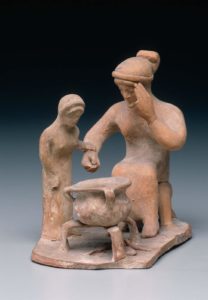Childhood is an understudied subject within ancient Greek academia. Much of this is due to the kinds of material preserved in the archaeological record. The lives of ordinary Greek children would have primarily existed within the “domestic realm”, a usually poorly preserved and under-excavated aspect of archaeology (Langdon 2013: 172).
Our understanding of the children of Greece subsequently surrounds the elite youths and the Spartans, topics favoured both by ancient sources and by the archaeological record itself.
However, considering that at any one time, under 18s can be estimated to have made up 30-40% of the population of the ancient world (Langdon 2013: 173), it is important for historians to try and bridge this gap. The lives of children not only reflected those of the adults around them, but their creativity and imagination meant that they also created their own cultures, as argued by Hirschfeld, and it is these cultures that we are working to develop our understanding of (2002).
The typical image of the lives of ancient Greek children is made up of young boys partaking in athletics and training to be soldiers, and young girls being taught how to tend to the home alongside their mothers. There is also evidence of play, with toys being found in many early child burials.
Langdon’s study (which is the main inspiration of our research) focuses on child manufacturing in ancient Greece as a result of the‘Chaîne opératoire’ process and suggests that children gained the knowledge to become producers through hereditary teachings (Langdon 2013: 186). Darvill translates and defines this phrase as an ‘operational sequence’ and a ‘social act’(Darvill 2009: 84), which involves many different groups within society as contributors within the production sequence, including children. Langdon references a section of Plato’s republic wherein ‘sons of potters look on as helpers a long time before they put their hands to the clay’ (Langdon 2013: 178 in reference to Plato Rep. 467a). Likewise, Plutarch’s Life of Solon refers to a law stating ‘no son who had not been taught a trade should be compelled to support his father’ (Plutarch, Life of Solon, 22.1). Both of these primary sources are first-hand interactions which support Langdon’s theory of children working alongside their parents. Acton, speaking of the Classical period, refers to the production of pottery as ‘a familiar part of ancient life’ (Acton 2014: 73), and that regular use pottery was produced by ‘undifferentiated’ groups of producers (Acton 2014: 249, table 9.1), which indicates an unregulated production process and leads to conclusions of possible inner-familial craftsmanship. For the sake of economy and accessibility, it would make logical sense for families to be able to produce their own pottery and to pass down the knowledge to ensure posterity.
Further evidence of the training of young children by their families is something that can be seen in ancient Greek art, specifically in figurines. There are multiple depictions of children working with adults to complete tasks. An example of this is a model dated to the Late Archaic Period that depicts what appears to be a young girl observing a woman cooking.
 Figure 1, Figurine of a woman and child cooking, dating to the Late Archaic Period, Museum of Fine Arts Boston 2020, Accession Number 01.7788
Figure 1, Figurine of a woman and child cooking, dating to the Late Archaic Period, Museum of Fine Arts Boston 2020, Accession Number 01.7788
Langdon’s proposal for the importance of family knowledge being passed down to children plays a part in how we see children in a wider context of Greek society, particularly within the ‘religious life of the community’ (Langdon 2013: 182). Through the use of archaeological and literary evidence discussed in this blog, we are able to delve into the societal role of children and the importance of their presence in the chain of production. For those interested in further study of children as producers in other socio-historical contexts and the learning of crafts during the early stages, we refer you to the brilliant article by Kamp 2001.
Bibliography
Primary Sources
Plutarch, Lives, Volume 1: Theseus and Romulus, Lycurgus and Numa, Solon and Publicola, trans. B. Perrin [Loeb Classical Library] 46 (Cambridge, MA 1914).
MUSEUM OF FINE ARTS BOSTON ‘Woman cooking, watched by a girl’ https://collections.mfa.org/objects/151733 (accessed 11 November 2020).
Secondary Sources
Acton, P. 2014. Poiesis: Manufacturing in Classical Athens. Oxford.
Darvill, T. 2009. The Concise Oxford Dictionary of Archaeology. Oxford and New York, NY.
Kamp, K. A. 2001. ‘Prehistoric Children Working and Playing: A Southwestern Case Study in Learning Ceramics’, in Journal of Anthropological Research, Vol. 57, No.4, pg.427-450.
Langdon, S. 2013. ‘Children as learners and producers in early Greece’ in Grubbs, J.E. and T. Parkin (eds.) The Oxford Handbook of Childhood and Education in the Classical World (Oxford).
Hirschfeld, L. 2002. ‘Why don’t anthropologists like children’. American Anthropologist, 104. 611-627.
